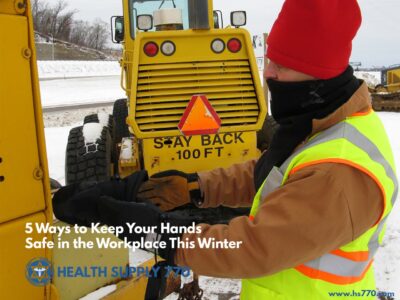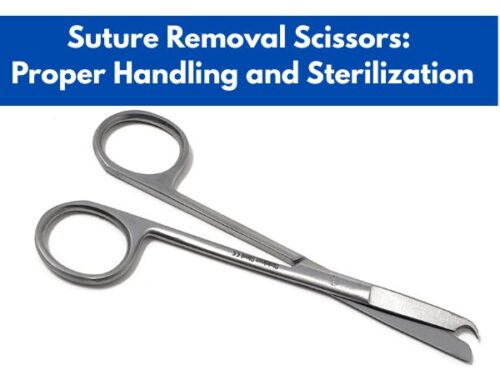5 Ways to Keep Your Hands Safe in the Workplace This Winter

Hands play an important role in every work environment, but this also makes them highly vulnerable to injury. Hand injuries are a serious risk in every workplace. While hand injuries are more common in manufacturing and industrial facilities, they can occur in any industry. Knowing the principles and remembering important hand safety rules is a smart approach to protecting yourself. After all, prevention is the greatest kind of protection.
With the possibility of severe temperature variations outside, industrial workers must be prepared to use hand gloves for protection from the elements throughout the winter. Cold weather increases the chance of hand injuries, whether caused directly by the cold or as a side effect that inhibits workers from performing their activities properly. When the weather outdoors is unpleasant, these five ways will help you keep your hands healthy and safe.
Best Tips to Keep Your Hands Safe in the Workplace This Winter:
1. Choose Winter Gloves Designed for Protection
The fact that hand gloves are thick does not indicate that they are built for cold weather and related concerns. You’ll need winter gloves made to survive cold, windy, and rainy environments. All-year-round worker health and safety depend on wearing gloves that fit properly and improve hand safety against certain industrial threats. Winter gloves should provide an additional layer of protection for employees, which includes having PPE that suits the exact measures of each person.
Wear a glove with a dual or thermal layer on the inside to keep hands and fingers warm, and a PVC coating on the outside to improve grip and protect against cold, moisture, oil, and grease when working in the cold. Anything less may cause your hand to become wet, uncomfortable, and perhaps slip inside the glove.
2. Get a Grip on Tool Handling
You should also be able to complete your task while wearing safety hand gloves. Before you or your team goes out in the workplace, test your tools and gloves to ensure that the gloves are comfortable and the tools are simple to use. Wrist and hand strain may be avoided by using the correct tools, and the right insulated work gloves can also protect against cold-related ailments. Check that they are waterproof, have a good grip, and are comfortable to wear.
Fit is also important. Poorly fitting gloves, whether too loose or too tight, increase the amount of effort necessary to complete a task, resulting in less control. Furthermore, tight gloves impair dexterity and grip strength, whereas loose gloves provide a catching hazard. Order gloves in a variety of sizes from manufacturers to guarantee workers have the proper fit and that their hands are properly covered.
3. Recognize Symptoms of Cold Stress
Employers should teach employees to know the symptoms of frostbite and other indicators of cold stress as a crucial step in ensuring worker safety. If you notice reduced blood flow to your hands, coldness, or tingling, this might indicate a serious health issue. Get out of the cold and take a rest before things become too unpleasant, or worse.
Frostbite is typically manifested by employees experiencing decreased blood flow to their hands as well as numbness or tingling. Recognizing cold stress signs may help employees know when to stop working outside in the cold to avoid winter-related hand injuries. Understanding these symptoms might help workers take appropriate breaks from the freezing environment and prevent such incidents.
4. Prepare for the Worst-Case Scenario
Unfortunately, incidents do happen. Keep medical supplies readily available so that workers may be treated if a health concern arises due to the cold on the job site. Warm beverages and blankets are simple ways to increase body temperature. Keep an inventory of heat packs or hand warmers to increase the heat provided by the hand gloves.
Employers should be prepared to assist workers who show symptoms of frostbite or other health-related issues by the cold by keeping medical equipment and supplies on hand. Don’t forget about your other safety requirements also; just because it’s cold outside doesn’t mean that other industrial risks stop existing. Be ready for everything.
5. Keep the Workplace Hazard-Free
It is not surprising that injuries from falls and slips increased throughout the winter. Our natural tendency to use our hands or arms to break our falls is the cause of many of these injuries. A radius fracture is the most frequent hand injury carried on by falling.
Radial fractures generally occur at the wrist joint with the force of a fall. By sedating or anesthetizing the patient and then adjusting the broken bone, several of these fractures can be treated without surgery. Surgery can be needed if the fracture is serious.
The greatest strategy to prevent a fracture from a fall is to avoid falling in the first place. A fall can be avoided through balancing exercises, appropriate winter footwear, attention to route conditions, and slowing down on slick terrain.
Conclusion
There are several factors to think about when selecting the best hand glove for your needs when it comes to keeping your hands warm in cold weather. Higher-quality, well-engineered winter gloves can cost a little bit more, but if you use the tips from our experts above, your hands will appreciate them this winter. Additionally, these tips will surely help you enhance hand safety in the workplace during winter.
FAQs
1. How can I protect my hands at work?
You can protect your hands in different work environments by using gloves with impact protection and by wearing fingerless gloves.
2. What are the 2 main types of safety gloves?
Safety gloves may be divided into two categories: reusable and disposable.
- Reusable gloves: Reusable gloves provide employees remarkable strength and durability as well as high resistance to chemical irritants.
- Disposable gloves: Disposable gloves are often less durable and thinner than their reusable versions.
3. Why is hand safety important?
Hand safety is important! We can perform so much with our hands. They have a wide range of abilities, including the ability to touch, grip, feel, hold, manipulate, caress, and more. Your hands are one of your greatest assets and must be protected.
4. Which part of your hands is most vulnerable to injury on the job?
Our fingers. Finger fractures can happen for a variety of conditions, such as incidents involving slammed doors or the improper use of power tools.


















